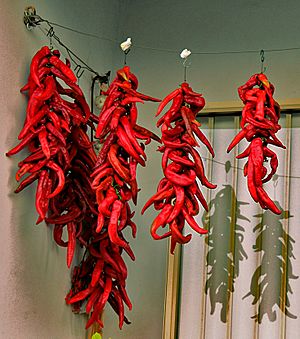Peperone di Senise facts for kids
 |
|
| Region or state | Basilicata |
|---|---|
The Peperone di Senise (say: peh-peh-ROH-neh dee seh-NEE-seh) is a special type of bell pepper. It comes from Senise, a town in Italy's Potenza province.
This pepper is a kind of Capsicum annuum plant. It's known for being sweet and having a thin skin. Since 1996, the Senise bell pepper has had a special label called "Protected Geographical Indication" (PGI). This means it's a unique product from a specific area.
What Makes It Special?
The Senise pepper can look different depending on its type. It might be pointed, hooked, or have a flat end. It always tastes sweet. Its color changes from green to a deep red or even purple.
These peppers are special because of their size and thin flesh, which is only about 1.5 to 2.2 millimeters thick. The stem, called the peduncle, is very strong. It stays attached even after the pepper is dried.
When dried, these peppers are often strung together. They form long "necklaces" called serte, which can be 1.5 to 2 meters long. You can buy Senise peppers fresh, dried, or even as a powder.
Peppers first arrived in Italy between the 1500s and 1600s. Farmers in Senise then chose and grew a special kind of pepper. Over time, this pepper became one of the most valued in Italy. At first, farmers grew it mostly for their own families. But later, it became a very important crop that helped them earn money.
One of the most popular ways to use Senise peppers is to dry them. They turn into a crispy bell pepper called "crusco". This "crusco" pepper is a key ingredient in the cooking of the Basilicata region.
Farmers dry Senise peppers naturally. They hang them in long strings in sunny, airy places. This lets the sun's rays dry them slowly. After drying, they might quickly put them in an oven. This removes any last bit of moisture. It also makes it easier to grind them into a spice. This spice is known as zafaran p'sat. It looks and feels a lot like saffron because of its color.
Where They Grow
The Senise pepper is mainly grown in the town of Senise. It also grows in some nearby towns in the Potenza and Matera provinces. To be called "peperoni di Senise," the peppers must come from these specific areas. This helps protect their special quality.
Festival
There's a special festival just for the Senise bell pepper! It's called "U strittul ru zafaran" (the alley of the bell pepper). This fun event happens every year on August 11.
Related articles
Sister projects
![]() Wikimedia Commons has more pictures and files about Peperone di Senise.
Wikimedia Commons has more pictures and files about Peperone di Senise.
See also
 In Spanish: Peperone di Senise para niños
In Spanish: Peperone di Senise para niños


